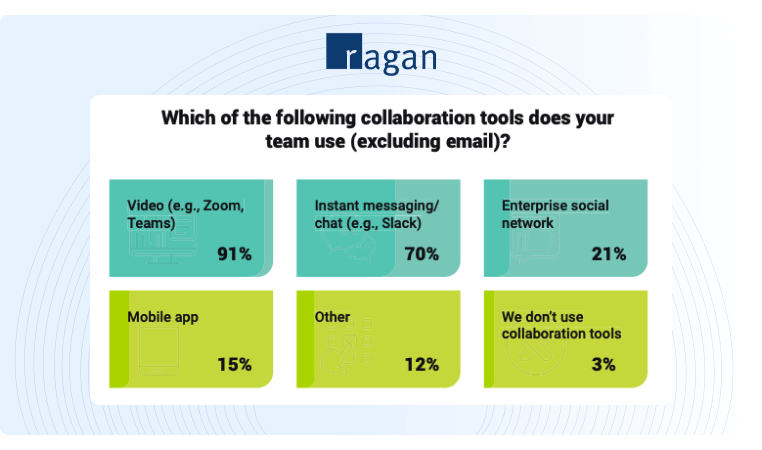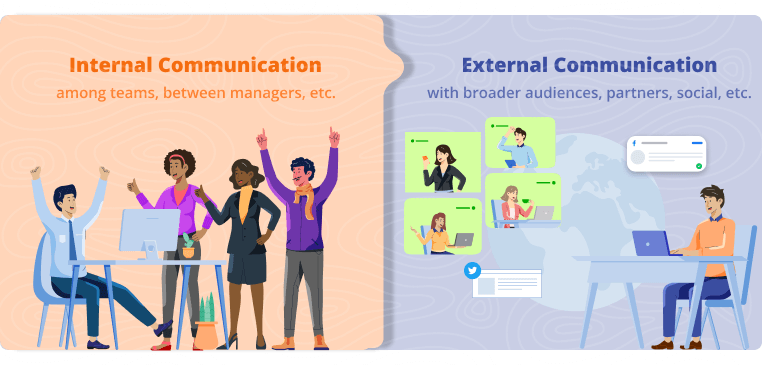External and Internal Communication: What They Are and Why They Matter
Effective communication is essential for workplace productivity and corporate growth. These channels of communication can be categorized as internal and external: the former includes communication between employees within the company, while the latter looks at information shared with stakeholders outside the organization. Both forms of communication play an important role in keeping the organization functioning efficiently.
Open channels of internal communication are important both for in-office workers and remote development teams, as all team members need to be on the same page. When internal communications break down, it means confused employees and low productivity. It would also hamper overall growth as employees would feel alienated from each other and the organization.
It is also imperative to have strong channels of external communication so your business can enjoy a sterling reputation with outsiders. The umbrella of external communication includes customers, partners, other stakeholders, and the larger population. External comms channels also dictate fiscal concerns like stock prices and funding, making these channels an important method of sharing information.
Internal and external communications should work together to create a smooth channel of information flow. While it’s true that internal team members communicate differently with each other as compared to communicating with customers via say small business VoIP or email, it’s still important for the company to have a consistent image and message.

Source: Ragan’s Salary Survey & Workplace Culture Report for 2022
But it's important to remember that this can only happen when both these forms of interpersonal communication are used in harmony. In this article, we're going to further explore why it's important that internal and external communications work together.
Internal vs External Communications
Before we dive into how and why these communication methods work better together, let’s take a deeper look at what they mean:
Internal Communications
Internal communication is the flow of information that passes between members of an organization. There are various tools – both through the cloud and on-premise – that may be used to increase this flow and make it as efficient as possible. Internal communication involves emails sent out to employees, lists of objectives and goals, standard operating procedure (SOPs), guidelines, and more.
There are four kinds of internal communication:
-
Vertical: team members on different hierarchical levels talk to each other
-
Downward: an employee in a higher leadership position communicates with a team member lower in the hierarchy
-
Upward: employees talk to their managers or supervisors
-
Horizontal: members at the same hierarchical level discuss work
External Communications
External communication is information the company shares with people outside of it. Think of an organization publishing an important press release about a charity event, or uploading a PSA for the general public. Anything that is communicated to a stakeholder not from the company counts as external communication, which includes your employee advocacy efforts. These can be both formal and informal.
Formally, external comms channels are used to build brand awareness, brand image, and reputation. Companies want customers to have a certain image of them. This is why they create commercials, refine their employee brand advocacy programs, and issue reports highlighting their product or service. Some organizations also set up call centers to reach out to stakeholders while others use cloud PBX solutions. It’s about establishing a transparent flow of communication with external partners.

Why Internal and External Communications Need to Work Together
According to SmallBizGenius, 82% of consumers feel more positive about a brand after reading customized content. What this means is that people are more likely to trust a company that speaks to them in meaningful ways and doesn’t spam them with useless information. A unified marketing communication strategy ensures consistency in tone, brand image, and messaging.
Employees that know what their brand is about can communicate that core message to a wider audience. They should be consistently briefed on what kind of information they can communicate, which tone of voice they should use and what kind of brand image the business is trying to build. The organization can fall apart like a loosely stacked house of cards if both of these channels of communication aren’t working in tandem.
Let’s take a closer look at what happens when internal and external communications work together:
Increased Return on Investment (ROI)
While it’s true that businesses set different Key Performance Indicators (KPIs) for various departments, the real objective is to turn a profit. No one goes into business just to make aesthetic social media posts and call it a day. Ultimately, it’s all about how much you’re selling and how well you’re doing it.
Brands that align their internal and external communications enjoy a higher ROI as compared to brands that don’t. This is thanks to consistent communication across all the touchpoints inside and outside your organization, leading to standardized service and/or quality. Your customers will be able to rely on your company to continually deliver the best, ensuring you get loyalty and new leads.

Source: Guide to Understanding and Improving Internal Communications in Your Business
Boosts Business Growth
Successful businesses expand rapidly. Meta bought Instagram to facilitate growth and Google took over YouTube. Fast-growing brands frequently engage in acquisitions and mergers but these moves shouldn’t be a surprise to the people who work for them.
Employees should be told about changes to their company as soon as possible, and shouldn’t find out from external sources. Not only does this hamper employee trust and productivity, but it can also delay product launches and slow down the implementation of integration software tools, and other internal initiatives. If your employees haven’t been informed or trained, they can’t communicate this information to customers, partners or vendors, leading to confused positioning being communicated.
When employees are informed (internal comms), they can disseminate the information in a meaningful way (external comms), giving you a stronger reputation and better brand image. This will also help boost your business growth as there won’t be breakdowns in the implementation of new tech or software tools.
Creates Numerous Brand Ambassadors
Effective internal communication leads to employee advocacy which then creates brand ambassadors for your business. It’s incredibly useful to have employee advocates from within the brand that genuinely believe in the organization’s core message. They can then give out useful information, engage in better quality conversations, and provide you a better talent pool to hire from.

Employee brand ambassadors can come in handy if you want more word-of-mouth marketing too. Take, for example, people who work in technology, wherein the company is involved in the modernization of mainframe for the business’s online transactions. That’s a pretty specific niche, but there can be people within the immediate social reach of the business’ employees who are into technology. Targeting this demographic can jumpstart interest in the business’ product, however specific. Eventually, this can result in more people visiting the business landing page and trying out the new feature.
Enthusiastic internal brand ambassadors will also be eager to inform the wider audience about any improvements in the business. They will ensure that the information being shared is consistent with the brand image and will write glowing copy that helps you attract more customers.
Allows Employees to Learn New Skills
What happens when you need to hire someone who handles your overall communication channels? Do you choose someone who’s an expert in internal comms or external information sharing? The correct answer is you don’t need to choose. The ideal hire for this role is someone who understands how to do both.
When you align your internal and external comms, you give existing employees different hats and level up their skills. For example, someone in an IT role can learn about microservices for development, resulting in a useful hybrid work role. They can use the same strategies they use on external stakeholders to keep internal team members motivated as well.
This applies to both remote and on-site workers. A marketing professional might research 'what is cloud communications’ and use their internal communications software to relay important internal information. Not only will they build a consistent brand image internally, but they will also align everyone on how to present it externally, saving the business the trouble of hiring two people where they could use one.
Are There Risks Involved?
As with any strategy, there is some risk involved when you mesh internal and external communications:
Cannibalization of Communication Efforts
There is a chance that external comms can override internal channels and cannibalize your efforts. This is because external communications are often given priority, considering they directly help businesses turn a profit.
Internal comms channels have an indirect effect and sales-focused business owners may end up sidelining them. Combining the two can result in the external taking over internal comms channels, possibly making employees feel devalued or isolated.

Security Risks
As with too many cooks stirring the proverbial pot, too many hybrid professionals can cause some security risks. Human error can’t be discounted when you have the same person looking over both internal and external communication channels. They may accidentally publish something not meant for external stakeholders on the company's social media page.
There’s also a chance that they could erroneously share sensitive information related to vendors with employees or team members. This could lead to sticky situations like data breaches or loss of trust within the team.
Business owners should be careful when combining internal and external communications because it’s possible for someone juggling various roles to get confused or slip up. So it’s well worth it to take your time when integrating your external and internal communication efforts.







